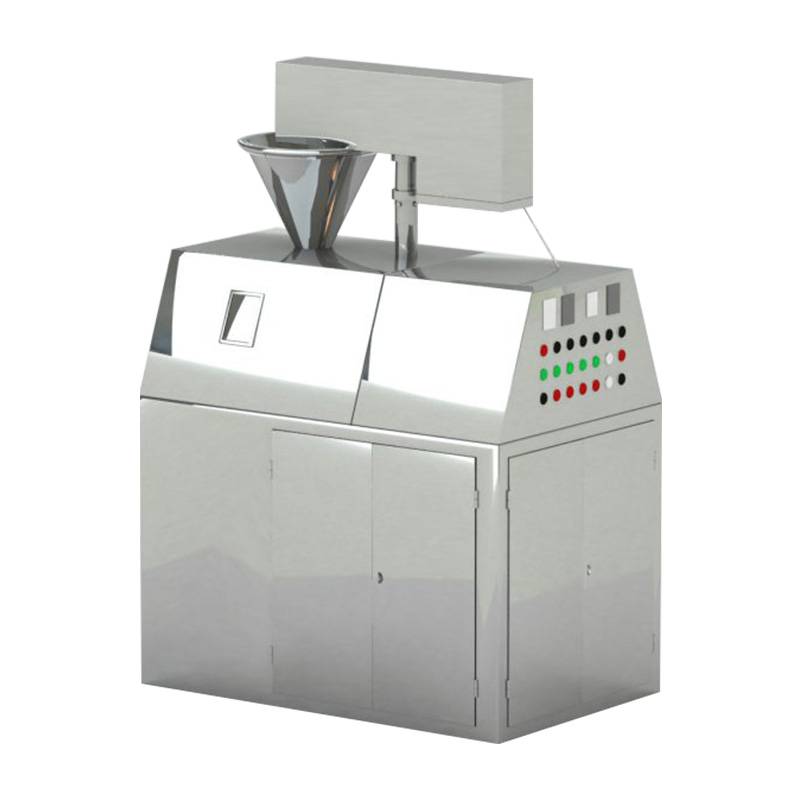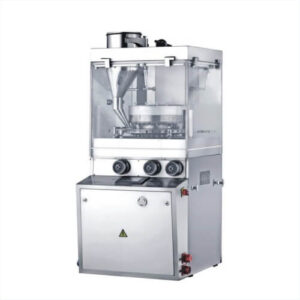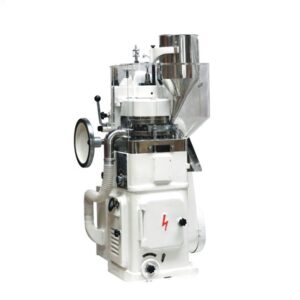Description
| Specification | Description |
|---|---|
| Model | GK Dry Granulator |
| Capacity | Varies based on the model; typically ranges from X to Y kg/h |
| Material | Stainless steel or carbon steel construction |
| Power Supply | Depends on the model; typically X volts, Y Hz, Z phase |
| Motor Power | Varies based on the model; typically ranges from X to Y kW |
| Granulation Method | Dry granulation process |
| Granule Size Range | Adjustable; typically ranges from X to Y mm |
| Operating Pressure | Adjustable; typically ranges from X to Y bar |
| Control System | PLC (Programmable Logic Controller) |
| Hopper Capacity | Varies based on the model; typically ranges from X to Y liters |
| Dimensions (L x W x H) | Depends on the model; which typically ranges from X to Y mm |
| Weight | Depends on the model; which typically ranges from X to Y kg |
| Optional Features | – Dust extraction system |
| – Variable speed control | |
| – Product discharge chute | |
| – Stainless steel finish |
Dry Granulation in Perspective
Dry granulation is an approach that transforms powder into granules by excluding liquids for binding or solvents. This method involves squeezing the powder to bind the particles together and finally achieving granules with chosen properties. Dry granulation is best suited for hygroscopic and heat-sensitive materials, as it eliminates drying steps during processing, thus reducing energy consumption and time.
The GK Dry Granulator
GK Dry Granulator is a highly efficient machine specifically designed for dry granulation processes. It employs a unique set of mechanisms and features to ensure effective and efficient granulation across a wide range of applications.
The Process of Working
The GK Dry Granulator operates on several consecutive steps:
Feeding: feeding through the hopper or feeder mechanism is how the powder material enters the granulator. The process assists in the proper distribution of powder within the zone where it occurs.
Compaction: In this stage, pressure compacts powdered material into dense ribbons or sheets. A compression force is exerted on a bed of powder by a pair of counter-rotating rolls.
Milling: The ribbon obtained after compaction can be milled into desired-size granules; wherein it’s pressed through a milling unit which typically consists of ribbed or smooth rolls that crush it into pieces.
Sizing: After milling, the resulting particles are screened to remove fines and attain uniform particle size distribution. The step has great implications for the specifications required for the final product which needs to be achieved.
Applications
As such, this high-performance machine is widely used across several industries due to its versatility and efficiency. Some common applications include;
Pharmaceutical Industry: For sensitive materials such as those that are moisture or heat-intolerant, pharmaceutical manufacturing commonly employs dry granulation techniques to make tablets from powders. Typically used in oral solid dosage forms production like tablets and capsules is the GK Dry Granulator.
Chemical Industry: In the chemical industry, the dry method instead allows for manufacturing granules from powdered raw materials such as fertilizers, catalysts, and specialty chemicals. With this machine, you can produce granules of a particular size and have control over their properties which makes it suitable for a wide range of chemical applications.
Food Industry: Dry granulation in the food industry is used to produce nutritional supplements, flavorings, and food additives in the form of granules. The GK Dry Granulator meets even stringent requirements of hygiene and uniformity found in the food processing sector.
Functions and Roles
Several key functions are carried out by GK Dry Granulator that contribute to its role in the manufacturing process:
Granulation: The main function of the GK Dry Granulator is converting powder into granules with specific sizes and characteristics. It creates particles that flow better, compress more readily, or have other desired properties via compacting and milling.
Particle Size Control: This helps to maintain consistency throughout the final product through careful regulation of particle size distribution within the granules. It is important to ensure meeting different industries’ quality standards and regulatory demands on them.
Material Handling: The GK Dry Granulator allows for efficient handling of powders, thus reducing dust generation during processing and minimizing losses. To ensure safety at work as well as cleanliness, it has been designed without opening and it also incorporates a dust extraction system.
Flexibility: GK Dry Granulator is flexible in terms of roll gap, compaction pressure, and milling speed; as a result, it can accommodate many different materials and process needs. In this way, productioners’ requirements change with time, so versatility is important in optimizing their productivity.
Advantages of GK Dry Granulator
The GK Dry Granulator presents numerous benefits over other granulation techniques thereby making it the most preferred option for various industries as listed below:
Cheaper Cost: Furthermore, not requiring expensive binders and drying equipment reduces manufacturing costs in the dry granulation process. Additionally, it consumes less energy and maintenance costs due to its small design that facilitates easy operation.
Product Quality: By avoiding moisture and heat during the process of dry granulation delicate substances remain uncomprise thus helping them keep product stability ensuring consistent quality from one batch to another. Moreover, for better functionality and performance of the products control is provided on the properties of the particles including their sizes.
Process Efficiency: The overall productivity will increase because of faster processing times as well as higher throughput rates while using the GK Dry Granulator. Besides that, this machine runs continuously resulting in smooth integration with existing production lines hence minimal downtime experienced by manufacturers thereby maximizing resource utility.
Environmental Sustainability: It does not involve solvent usage which makes wet granulation a more sustainable process compared to the dry method. To make it environmentally friendly, some machines like GK Dry Granulator have been designed to include recycling systems or energy-efficient motors to reduce carbon footprint.
Regulatory Compliance: It meets pharmaceutical industry regulations alongside standards set by regulators like the FDA for drug manufacturing purposes through sanitary construction among other things such as validation documentation.The good manufacturing practices (GMP) standard also permits easy cleaning during sanitary operations.
FAQs
What is a GK Dry Granulator?
These are machines used in food, chemicals, and pharmaceutical sectors for conducting dry granulations whereby powder particles are compacted into solid masses without the addition of liquid binders to form granules with improved characteristics.
How does the GK Dry Granulator work?
GK Dry Granulator works by compressing the powder material under high pressure between two rolls that move in opposite directions within a compaction zone. Thereafter, the compacted product is milled and sized leading to the formation of granules with specific properties and sizes.
What are the applications of the GK Dry Granulator?
The pharmaceutical industry uses GK Dry Granulator to produce tablets and capsules; the chemical industry uses it for making fertilizers and specialty chemicals while the food industry uses it to make nutritional supplements, as well as additives for other foods.
What functions does the GK Dry Granulator serve?
Consequently, it can be categorized into several activities such as granulation of powders, and particle size control pellets which are efficient in handling different materials among others since they allow flexibility when processing multiple materials or meeting different demands.
What are the advantages of using the GK Dry Granulator?
Therefore, this procedure is considered cost-effective due to its ability to save on manufacturing costs, and superior quality products at low costs compared to other methods but not limited to them.
How does the GK Dry Granulator contribute to cost savings?
The manufacturers will therefore benefit from savings associated with a lack of need for costly binders or drying devices, reduced energy utilization, and maintenance expenses through better overall productivity resulting from operational efficiency.
What features ensure product quality with the GK Dry Granulator?
In this sense delicate substances remain uncompromised thus helping them keep product stability ensuring consistent quality from one batch to another. Also, for better functionality and performance of the products control is provided on the properties of particles including their sizes.
Why does process efficiency increase with the GK Dry Granulator?
GK Dry Granulator has higher productivity, extremely short processing time, unbroken running, and ease of integration into already existing production lines leading to minimum downtime and maximum resource utilization.
What are some environmental advantages of using the GK Dry Granulator?
The GK Dry Granulator also ensures that there is no need for solvents, which minimizes wastewater generation. It makes use of energy-efficient features and promotes sustainability in manufacturing.
How does the GK Dry Granulator ensure regulatory compliance?
It can stand out in terms of meeting regulatory standards as well as satisfying industry guidelines. Sanitary construction, easy cleanability, and validation documentation therefore confirm its adherence to Good Manufacturing Practices (GMP) as well as other regulations.





Reviews
There are no reviews yet.